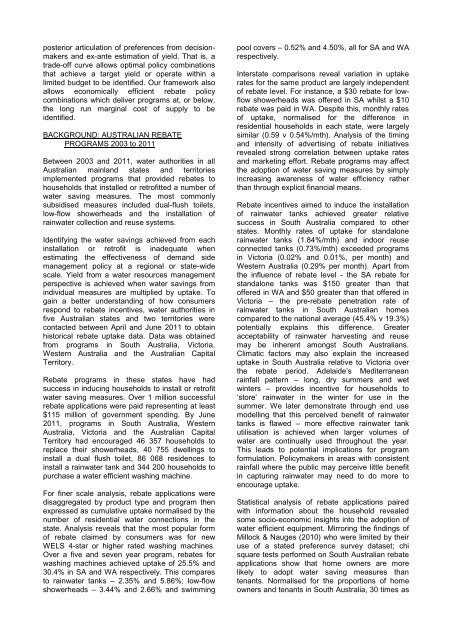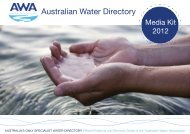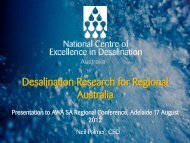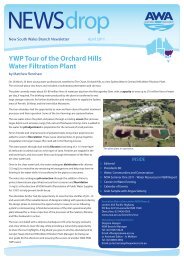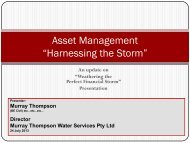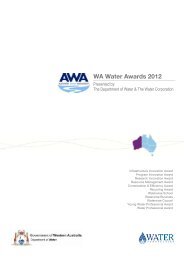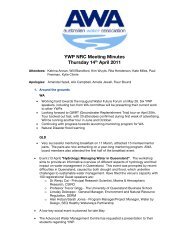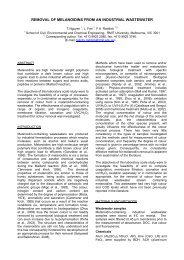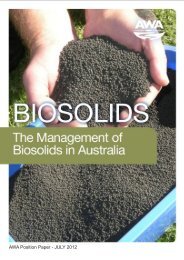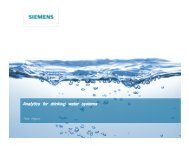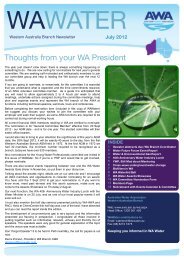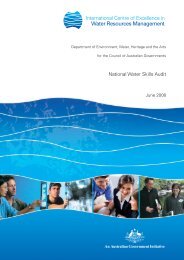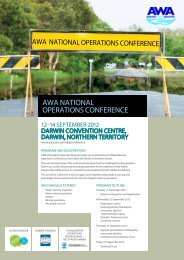Optimum Use of Subsidies for Reducing Domestic Water Consumption
Optimum Use of Subsidies for Reducing Domestic Water Consumption
Optimum Use of Subsidies for Reducing Domestic Water Consumption
You also want an ePaper? Increase the reach of your titles
YUMPU automatically turns print PDFs into web optimized ePapers that Google loves.
posterior articulation <strong>of</strong> preferences from decisionmakers<br />
and ex-ante estimation <strong>of</strong> yield. That is, a<br />
trade-<strong>of</strong>f curve allows optimal policy combinations<br />
that achieve a target yield or operate within a<br />
limited budget to be identified. Our framework also<br />
allows economically efficient rebate policy<br />
combinations which deliver programs at, or below,<br />
the long run marginal cost <strong>of</strong> supply to be<br />
identified.<br />
BACKGROUND: AUSTRALIAN REBATE<br />
PROGRAMS 2003 to 2011<br />
Between 2003 and 2011, water authorities in all<br />
Australian mainland states and territories<br />
implemented programs that provided rebates to<br />
households that installed or retr<strong>of</strong>itted a number <strong>of</strong><br />
water saving measures. The most commonly<br />
subsidised measures included dual-flush toilets,<br />
low-flow showerheads and the installation <strong>of</strong><br />
rainwater collection and reuse systems.<br />
Identifying the water savings achieved from each<br />
installation or retr<strong>of</strong>it is inadequate when<br />
estimating the effectiveness <strong>of</strong> demand side<br />
management policy at a regional or state-wide<br />
scale. Yield from a water resources management<br />
perspective is achieved when water savings from<br />
individual measures are multiplied by uptake. To<br />
gain a better understanding <strong>of</strong> how consumers<br />
respond to rebate incentives, water authorities in<br />
five Australian states and two territories were<br />
contacted between April and June 2011 to obtain<br />
historical rebate uptake data. Data was obtained<br />
from programs in South Australia, Victoria,<br />
Western Australia and the Australian Capital<br />
Territory.<br />
Rebate programs in these states have had<br />
success in inducing households to install or retr<strong>of</strong>it<br />
water saving measures. Over 1 million successful<br />
rebate applications were paid representing at least<br />
$115 million <strong>of</strong> government spending. By June<br />
2011, programs in South Australia, Western<br />
Australia, Victoria and the Australian Capital<br />
Territory had encouraged 46 357 households to<br />
replace their showerheads, 40 755 dwellings to<br />
install a dual flush toilet, 86 068 residences to<br />
install a rainwater tank and 344 200 households to<br />
purchase a water efficient washing machine.<br />
For finer scale analysis, rebate applications were<br />
disaggregated by product type and program then<br />
expressed as cumulative uptake normalised by the<br />
number <strong>of</strong> residential water connections in the<br />
state. Analysis reveals that the most popular <strong>for</strong>m<br />
<strong>of</strong> rebate claimed by consumers was <strong>for</strong> new<br />
WELS 4-star or higher rated washing machines.<br />
Over a five and seven year program, rebates <strong>for</strong><br />
washing machines achieved uptake <strong>of</strong> 25.5% and<br />
30.4% in SA and WA respectively. This compares<br />
to rainwater tanks – 2.35% and 5.86%; low-flow<br />
showerheads – 3.44% and 2.66% and swimming<br />
pool covers – 0.52% and 4.50%, all <strong>for</strong> SA and WA<br />
respectively.<br />
Interstate comparisons reveal variation in uptake<br />
rates <strong>for</strong> the same product are largely independent<br />
<strong>of</strong> rebate level. For instance, a $30 rebate <strong>for</strong> lowflow<br />
showerheads was <strong>of</strong>fered in SA whilst a $10<br />
rebate was paid in WA. Despite this, monthly rates<br />
<strong>of</strong> uptake, normalised <strong>for</strong> the difference in<br />
residential households in each state, were largely<br />
similar (0.59 v 0.54%/mth). Analysis <strong>of</strong> the timing<br />
and intensity <strong>of</strong> advertising <strong>of</strong> rebate initiatives<br />
revealed strong correlation between uptake rates<br />
and marketing ef<strong>for</strong>t. Rebate programs may affect<br />
the adoption <strong>of</strong> water saving measures by simply<br />
increasing awareness <strong>of</strong> water efficiency rather<br />
than through explicit financial means.<br />
Rebate incentives aimed to induce the installation<br />
<strong>of</strong> rainwater tanks achieved greater relative<br />
success in South Australia compared to other<br />
states. Monthly rates <strong>of</strong> uptake <strong>for</strong> standalone<br />
rainwater tanks (1.84%/mth) and indoor reuse<br />
connected tanks (0.73%/mth) exceeded programs<br />
in Victoria (0.02% and 0.01%, per month) and<br />
Western Australia (0.29% per month). Apart from<br />
the influence <strong>of</strong> rebate level - the SA rebate <strong>for</strong><br />
standalone tanks was $150 greater than that<br />
<strong>of</strong>fered in WA and $50 greater than that <strong>of</strong>fered in<br />
Victoria – the pre-rebate penetration rate <strong>of</strong><br />
rainwater tanks in South Australian homes<br />
compared to the national average (45.4% v 19.3%)<br />
potentially explains this difference. Greater<br />
acceptability <strong>of</strong> rainwater harvesting and reuse<br />
may be inherent amongst South Australians.<br />
Climatic factors may also explain the increased<br />
uptake in South Australia relative to Victoria over<br />
the rebate period. Adelaide‟s Mediterranean<br />
rainfall pattern – long, dry summers and wet<br />
winters – provides incentive <strong>for</strong> households to<br />
„store‟ rainwater in the winter <strong>for</strong> use in the<br />
summer. We later demonstrate through end use<br />
modelling that this perceived benefit <strong>of</strong> rainwater<br />
tanks is flawed – more effective rainwater tank<br />
utilisation is achieved when larger volumes <strong>of</strong><br />
water are continually used throughout the year.<br />
This leads to potential implications <strong>for</strong> program<br />
<strong>for</strong>mulation. Policymakers in areas with consistent<br />
rainfall where the public may perceive little benefit<br />
in capturing rainwater may need to do more to<br />
encourage uptake.<br />
Statistical analysis <strong>of</strong> rebate applications paired<br />
with in<strong>for</strong>mation about the household revealed<br />
some socio-economic insights into the adoption <strong>of</strong><br />
water efficient equipment. Mirroring the findings <strong>of</strong><br />
Millock & Nauges (2010) who were limited by their<br />
use <strong>of</strong> a stated preference survey dataset; chi<br />
square tests per<strong>for</strong>med on South Australian rebate<br />
applications show that home owners are more<br />
likely to adopt water saving measures than<br />
tenants. Normalised <strong>for</strong> the proportions <strong>of</strong> home<br />
owners and tenants in South Australia, 30 times as


